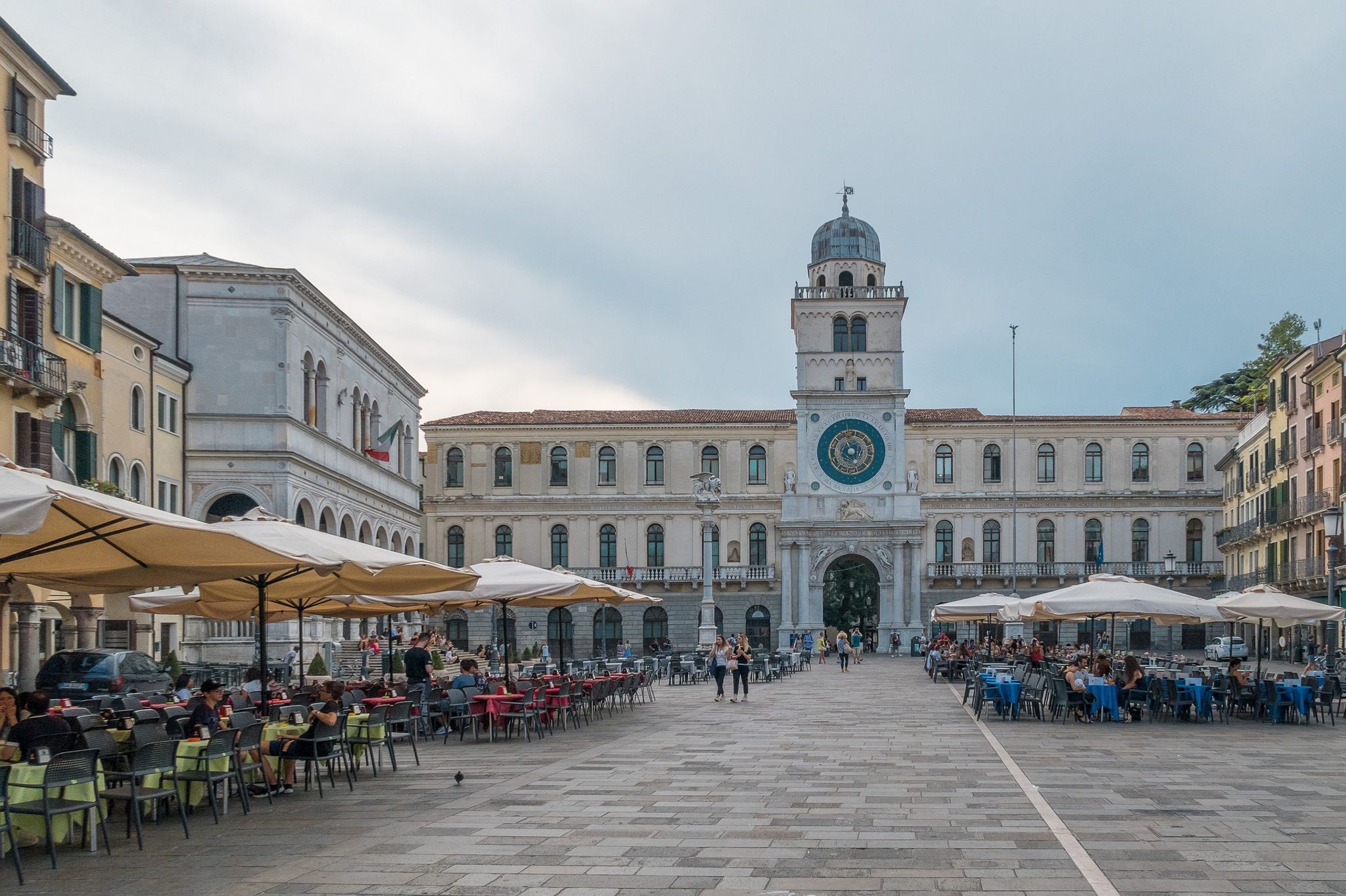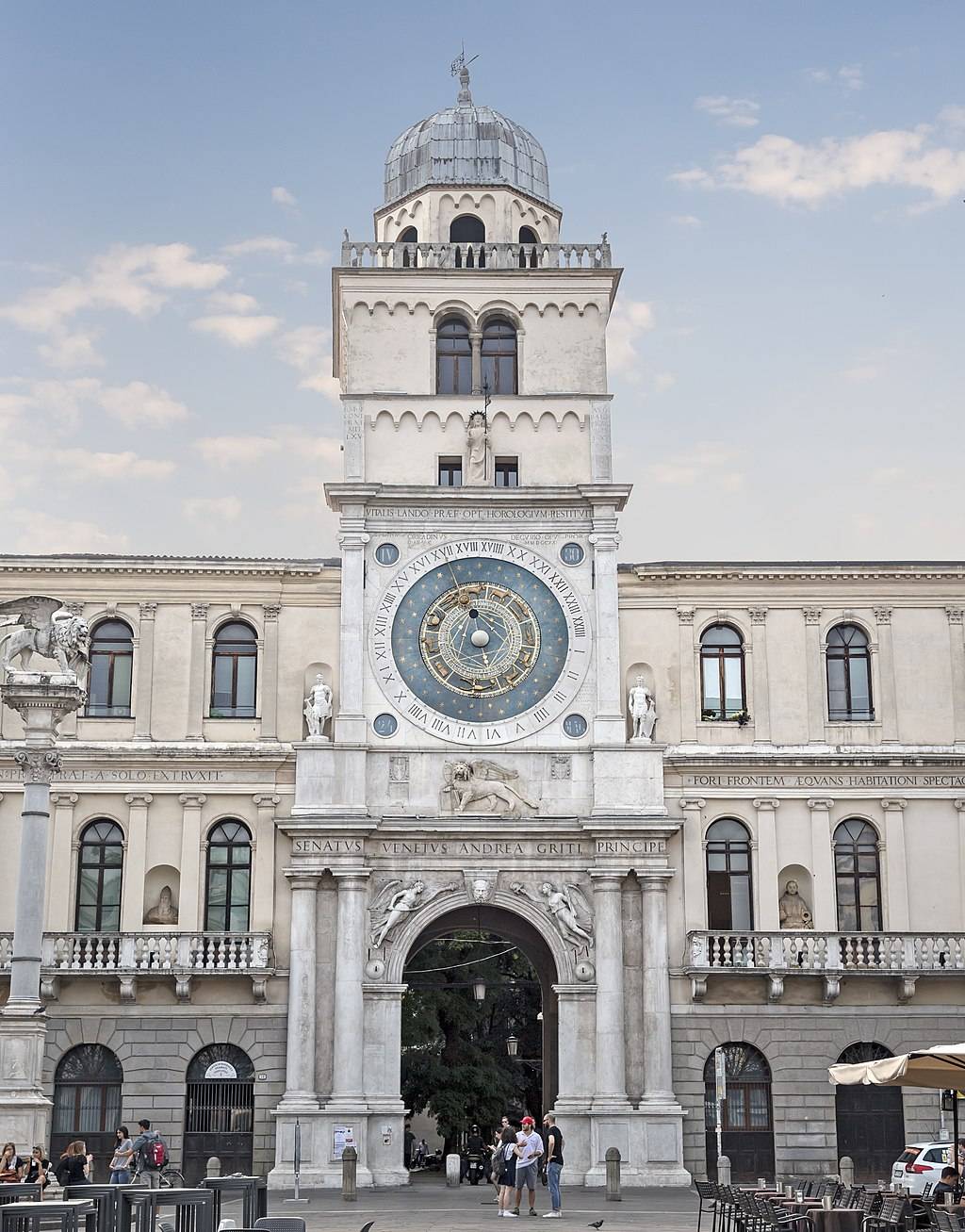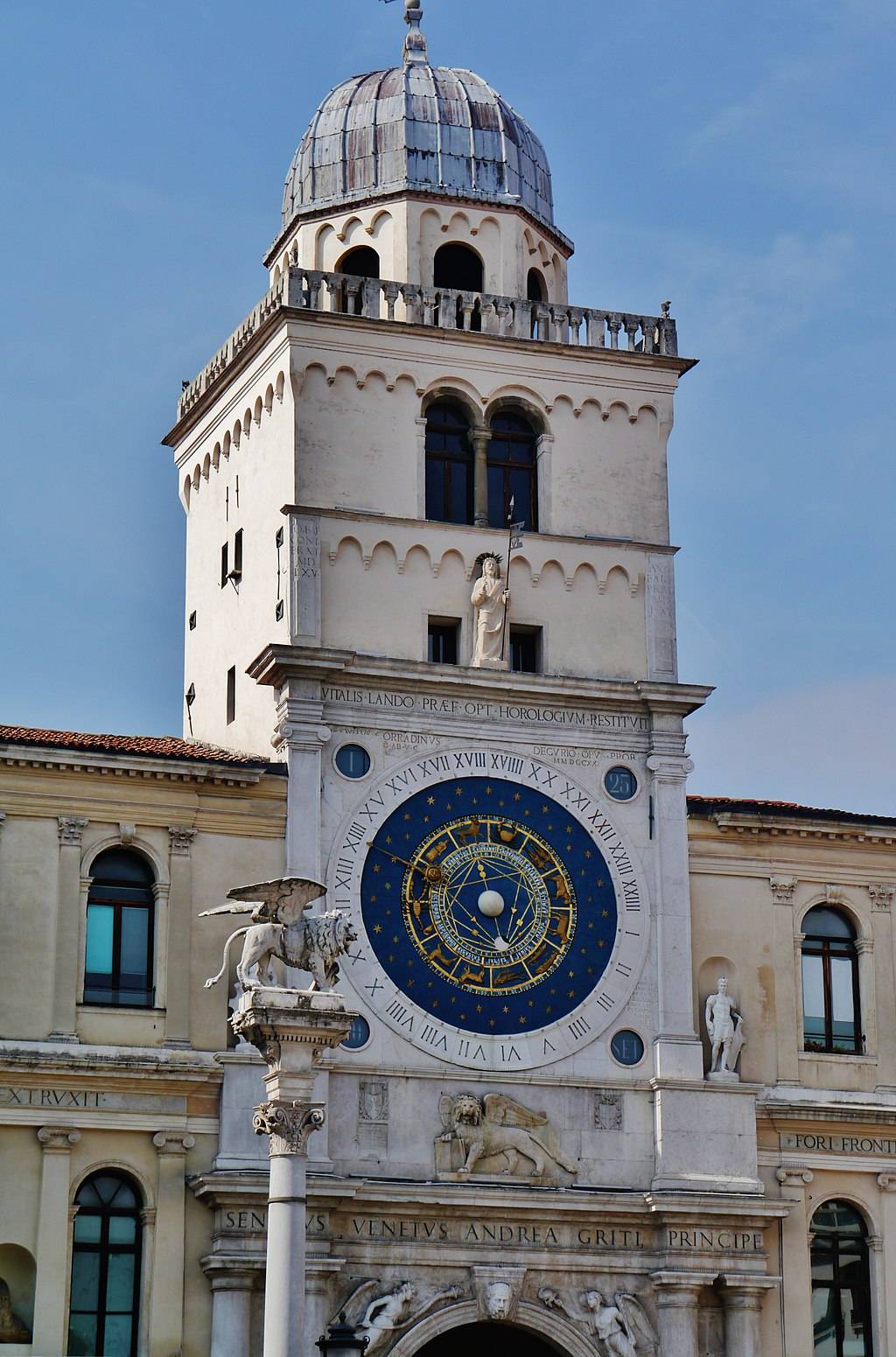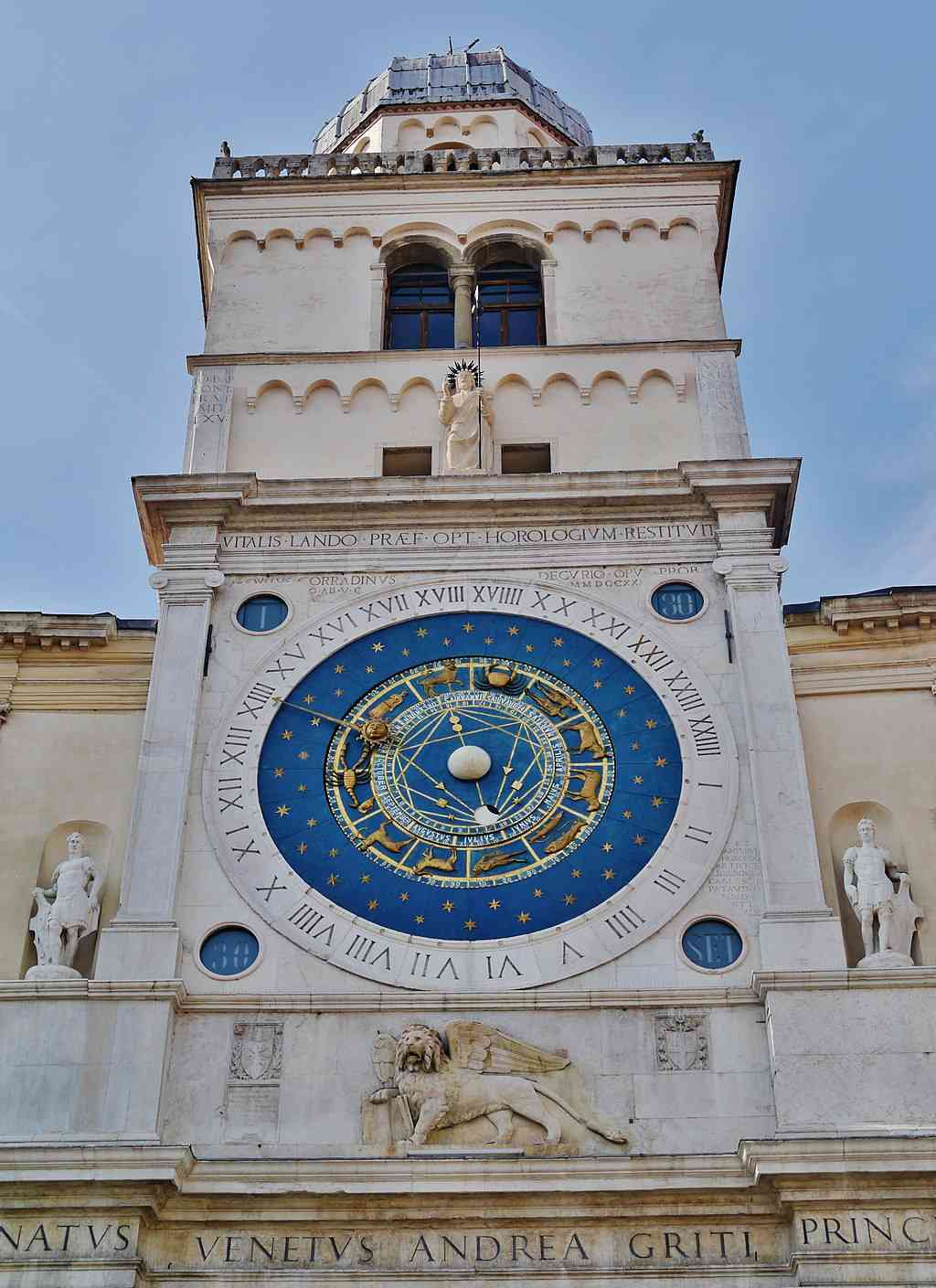The Astronomical Clock Tower
Torre dell'Orologio is a medieval clock tower which rises between the Piazza del Capitaniato and Piazza dei Signori, representing one of the symbols of the Carrarese era in Padua.

The Clock Tower is a building from the medieval period of the Cararesse signoria, a period of prosperity and cultural flourishing before becoming a province of the Venetian Republic in 1405. The stately tower characterises the appearance of the splendid Piazza dei Signori. It stands between the Palazzo del Capitanio and the Palazzo dei Camerlenghi.
The Tower was built in the fourteenth century as the eastern gate of the Palazzo Carrarese, whose courtyard stood on the present Piazza del Capitaniato. The first clock designed by Jacopo Dondi was installed in the tower in 1344, an astronomical clock indicating hours, months, moon phases and the course of the sun through the signs of the zodiac. It was destroyed in 1390 when the Milanese and Venetian armies stormed the palace, in an effort to stop the rapid expansion of Padua by sending the da Cararra family into exile.
After Padua came to be under the Venetian domination, the buildings of the Palazzo Carraresi were settled by the Venetian Capitanio and exponents of the Paduan administration. Thus, in 1428 the Clock tower was rebuilt and adorned with the symbols of the Republic of Venice: the Lion of Saint Mark and two figures bearing the coats of arms of the mayor Giovanni Badoer and the captain Giovanni Moro. The tower was equipped with a new astronomical clock, built by a descendant of Jacopo, Novello Dondi dall'Orologio, following the designs of the previous one. This was 70 years prior to the construction of the renowned Saint Mark's Clock Tower in Venice.
In 1531 the great Triumphal Arch was added to the base, connecting Piazza dei Signori with Piazza Capitaniato. It is a round arch made of Istrian stone, with four Doric columns resting on a high base, the work of Giovanni Maria Falconetto, designed on the model of the ancient Roman triumphal arches.
The Tower is 30 meters high from the street level. It is surmounted by an octagonal drum supporting a dome covered with lead plates, where a bell is installed, still operating today on the original fifteenth-century mechanism.
The Tower is famous for the so-called ribotto: five minutes after having struck the hour, the bell chimes again with the same number of strokes. It is an ancient tradition linked to trade. When the negotiations were beginning to take too long, the first chime indicated the time while the ribotto decisively decreed the end of the agreement.
The Tower is internally structured on five floors, the third floor housing the clock precious mechanism, while the upper two were the residence of the master watchmaker who took care of maintenance.
The astronomical clock
The astronomical clock was built based on a project from 1344 by Jacopo Dondi, a professor of medicine and astronomy at the University. The watch’s popularity was such that the term "dell'Orologio" was added to the name of the descendants of Jacopo Dondi.
In his book from 1623, Della Felicità di Padova, Angelo Portenari described the tower as follows:
It is a beautiful tower covered with lead, in which is the most exquisite clock, which, beyond the striking and showing the hours, displays the day of the month, the course of the Sun through the twelve signs of the Zodiac, and the phases of the moon with its growing and waning.
The dial has a circular shape with a layout of a series of concentric bands. The outer band shows a 24-hour numbering scheme in Roman numerals, a widely used system in Italy’s 14th and 15th centuries. The second band has decorative coppery stars in lead plates, while the third band contains the zodiac symbols, finished with a pure gold leaf. The following bands indicate the days and months, the phases of the moon, and the motion of the planets. At the centre is the Earth, following the Ptolemaic astronomical theory of a geocentric system that placed the Earth at the centre of the Universe.
Among the signs of the Zodiac on the dial, the sign of Libra is missing. This lack is due to the fact that in the Ptolemaic zodiacal system, the constellations of Scorpio and Libra are united. The symbol of Libra was subsequently placed in the marble base that holds the flagpole. But there is a popular legend telling that the Libra symbol is missing because the builder deliberately didn’t include it in the cycle in an instance of spite against the client, who wanted to pay a lower price than the agreed amount.
The clock was seriously damaged in a fire and rebuilt in 1436 by Matteo Novello and Gian Pietro delle Caldiere, who reused the original signs of the Zodiac. A century later, Falconetto restored the facade of the Tower and created the cornices inspired by Ionic pilasters.
In June 2010, the clock started working again after a long restoration work, which involved both the structure of the Tower and the mechanisms of the clock.
References
The Clock Tower can be visited free of charge thanks to the work of the volunteers of the Salvalarte group of Legambiente:
Wednesday, Friday: two visits at 9.30 and 11.15
Saturday: four visits at 9.30, 11.15, 15.30 and 17.00
for up to 4 persons per turn
Reservation MANDATORY: salvalarte@legambientepadova.it
For further information:
+39 392 476 4353 (also WhatsApp) from 9:30 until 12:00 and from 15:30 until 18:00
We welcome all contributions, no matter how small. Even a spelling correction is greatly appreciated.
All submissions are reviewed before being published.
Continue to changelog-

© 'Torre dell'Orologio' by Gerhard Bögner Attribution copied to clipboard Failed copying attribution to clipboard -

© 'La Torre dell'Orologio' by Didier Descouens is licensed under CC BY-SA 4.0 Attribution copied to clipboard Failed copying attribution to clipboard -

© 'Clock Tower in Piazza dei Signori' by Zairon is licensed under CC BY-SA 4.0 Attribution copied to clipboard Failed copying attribution to clipboard -

We welcome all contributions.
All submissions are reviewed before being published.
We welcome all contributions, no matter how small. Even a spelling correction is greatly appreciated.
All submissions are reviewed before being published.
Continue to changelogWe welcome all contributions, no matter how small. Even a spelling correction is greatly appreciated.
All submissions are reviewed before being published.
Continue to changelogWe welcome all contributions, no matter how small. Even a spelling correction is greatly appreciated.
All submissions are reviewed before being published.
Continue to changelogCategory
Cost
-
41 m
One of the beautiful Venetian buildings surrounding the square of Piazza dei Signori is Loggia del Consiglio, an outstanding example of the architecture of the 15th and 16th centuries.
-
53 m
Piazza dei Signori is an elegant open square surrounded by monumental works, fulfilling the role of the grand living room of Padua.
-
109 m
The Church of San Clemente is a small Baroque-style Roman Catholic church with an ancient history overlooking the Piazza dei Signori.
-
The Chapel with its frescoes painted by Guariento is a fantastic testimony of the splendor of what used to be the Carrara Palace
-
131 m
The masterwork by Giusto de' Menabuoi, the frescoes are inspired by scenes from the Old and New Testaments, which culminates in the splendid image of Christ in Paradise




